Will Pfeifer's Blog, page 51
August 7, 2011
MTV RIP, Part Two: Fall of the House of Nouveaux
As I mentioned before, a lot of bands that appeared on MTV were a complete mystery to a kid in Niles, Ohio, and though I've expanded my musical tastes and depth of knowledge since those days, some of the bands remain a complete mystery.
Take, for instance, Classix Nouveaux. Aside from the video below and the fact that they've got an incredibly pretentious name, I know nothing about them. Sure, a simple trip to Wikipedia could probably explain everything, but be honest -- isn't the mystery of a barely remembered video much better than the reality of an actual band?
So here's the video. It played constantly back in those early MTV days and became so well known among the student body of Niles McKinley High School that one afternoon, when we were for some reason herded into the auditorium and shown Roger Corman's "Fall of the House of Usher," a classmate of mine started singing "Guilty, guilty you found me ...." at the top of his lungs when a scene in the movie slightly resembled a scene in the video.
Coming up next: The video that made my mom turn off the TV.
Take, for instance, Classix Nouveaux. Aside from the video below and the fact that they've got an incredibly pretentious name, I know nothing about them. Sure, a simple trip to Wikipedia could probably explain everything, but be honest -- isn't the mystery of a barely remembered video much better than the reality of an actual band?
So here's the video. It played constantly back in those early MTV days and became so well known among the student body of Niles McKinley High School that one afternoon, when we were for some reason herded into the auditorium and shown Roger Corman's "Fall of the House of Usher," a classmate of mine started singing "Guilty, guilty you found me ...." at the top of his lungs when a scene in the movie slightly resembled a scene in the video.
Coming up next: The video that made my mom turn off the TV.
Published on August 07, 2011 12:23
August 5, 2011
MTV RIP, Part One: Pat Benatar stalks you, the home viewer
In honor of this being MTV's 30th birthday month (and doesn't that make all of us feel so damned old), I thought I'd put a little quick-and-easy content on this site by posting a few videos I remember back from the channel's early days.
MTV hit our little town of Niles, Ohio, sometime during my freshman year of high school, which means we got it fairly early in its global infection cycle. Back then, when every radio station for 100 miles was mired in what wasn't yet called "classic rock," the only new stuff you heard were the blanderific tunes of the late 1970s and early 1980s. The glory days of AM radio were long gone, and the dial was full of Zeppelin and its warmed-over clones. The great thing about MTV in those early days wasn't so much the visual element, it was that the music was new -- and, to our rust belt ears, wonderfully weird.
If you caught any of the first hour of MTV that aired this week (on, where else, VH1 Classic), you might remember "veejay" Mark Goodman endlessly hyping the fact that MTV was, in fact, being broadcast on radio stations, meaning -- in those days before stereo TV sets -- you could tune it in and hear it in stereo. I didn't care about that, but I did sit there watching MTV with my boombox at the ready, and when a song came on the TV that I liked, I'd push "record," making my own MTV-fueled mix tape. That's how we collected music for free in the old days, kids.
By the way, to demonstrate how forward thinking I was about pop culture back then, I distinctly remember loudly proclaiming that MTV would never last for the simple reason that there weren't enough music videos to fill all those hours of programming. Pretty smart, eh?
And speaking of videos, here's one I remember seeing virtually nonstop back in those first months of zoning out in front of the set for hours. Everyone knows the Buggles' "Video Killed the Radio Star" was the first video, right? Do you know the second? It was Pat Benatar's "You Better Run." Yes, Ms. Benatar got plenty of airplay back then, for the simple reasons that (a) she was popular (b) she was attractive, especially in that distinctly very early '80s way, and (c) she had videos. More than anything, that's what determined if a band was on MTV -- and why so many British bands we'd never heard of were suddenly on our TV screens.
But, back to Benatar. "You Better Run" was the pioneer, "Heartbreaker" was a bigger hit, and "Shadows of the Night" was more elaborate (with that goofy World War II setting), but the video I always remember was this one, which epitomizes those early videos, with all that neon, the urban setting, that crazy '80s makeup and those no-budget camera effects. Enjoy...
Coming up next: Roger Corman, a high school assembly and a forgotten band
MTV hit our little town of Niles, Ohio, sometime during my freshman year of high school, which means we got it fairly early in its global infection cycle. Back then, when every radio station for 100 miles was mired in what wasn't yet called "classic rock," the only new stuff you heard were the blanderific tunes of the late 1970s and early 1980s. The glory days of AM radio were long gone, and the dial was full of Zeppelin and its warmed-over clones. The great thing about MTV in those early days wasn't so much the visual element, it was that the music was new -- and, to our rust belt ears, wonderfully weird.
If you caught any of the first hour of MTV that aired this week (on, where else, VH1 Classic), you might remember "veejay" Mark Goodman endlessly hyping the fact that MTV was, in fact, being broadcast on radio stations, meaning -- in those days before stereo TV sets -- you could tune it in and hear it in stereo. I didn't care about that, but I did sit there watching MTV with my boombox at the ready, and when a song came on the TV that I liked, I'd push "record," making my own MTV-fueled mix tape. That's how we collected music for free in the old days, kids.
By the way, to demonstrate how forward thinking I was about pop culture back then, I distinctly remember loudly proclaiming that MTV would never last for the simple reason that there weren't enough music videos to fill all those hours of programming. Pretty smart, eh?
And speaking of videos, here's one I remember seeing virtually nonstop back in those first months of zoning out in front of the set for hours. Everyone knows the Buggles' "Video Killed the Radio Star" was the first video, right? Do you know the second? It was Pat Benatar's "You Better Run." Yes, Ms. Benatar got plenty of airplay back then, for the simple reasons that (a) she was popular (b) she was attractive, especially in that distinctly very early '80s way, and (c) she had videos. More than anything, that's what determined if a band was on MTV -- and why so many British bands we'd never heard of were suddenly on our TV screens.
But, back to Benatar. "You Better Run" was the pioneer, "Heartbreaker" was a bigger hit, and "Shadows of the Night" was more elaborate (with that goofy World War II setting), but the video I always remember was this one, which epitomizes those early videos, with all that neon, the urban setting, that crazy '80s makeup and those no-budget camera effects. Enjoy...
Coming up next: Roger Corman, a high school assembly and a forgotten band
Published on August 05, 2011 18:22
August 2, 2011
Advance Team Tuesday: Five random panels
With all the recent tributes to science fiction writers and rambling odes to electronic sci-fi games, I almost forgot the main reason for these "Advance Team Tuesday" entries -- to hype the damned graphic novel, of course.
So, in that spirit, here are five fairly random panels from the book, offered without comment, that I hope you'll find intriguing. They're taken from all over the book, from beginning to end, and most feature our hapless hero, Zack McKinley, seen at various points in his haphazard, half-assed effort to save the world...
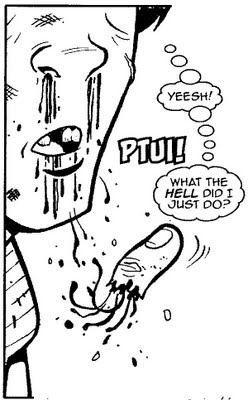
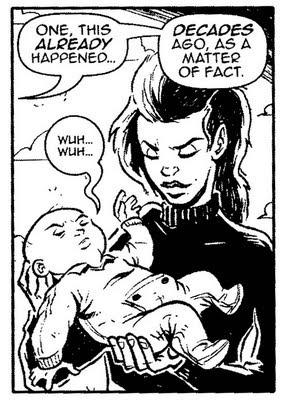
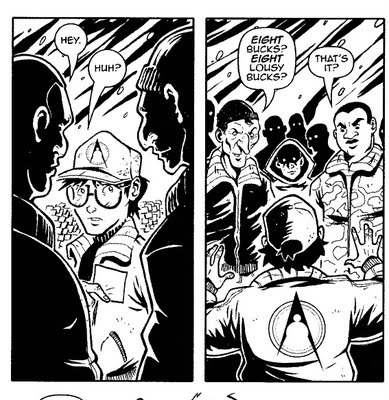
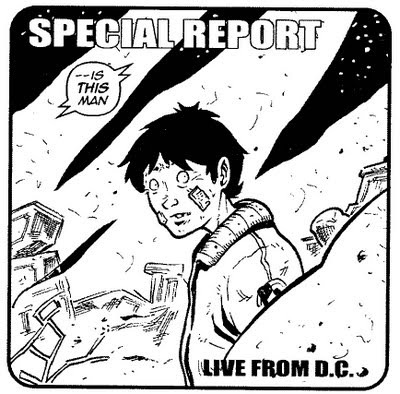 Want to see more? Good. I'll post some more panels in this spot in the coming months, and you'll be able to buy your own copy of "The Advance Team" when Tor/Forge books publishes it in 2012.
Want to see more? Good. I'll post some more panels in this spot in the coming months, and you'll be able to buy your own copy of "The Advance Team" when Tor/Forge books publishes it in 2012.
Art, by the way, is by the talented German Torres. His website is here, and you can find more art from "The Advance Team" when you click over.

So, in that spirit, here are five fairly random panels from the book, offered without comment, that I hope you'll find intriguing. They're taken from all over the book, from beginning to end, and most feature our hapless hero, Zack McKinley, seen at various points in his haphazard, half-assed effort to save the world...



 Want to see more? Good. I'll post some more panels in this spot in the coming months, and you'll be able to buy your own copy of "The Advance Team" when Tor/Forge books publishes it in 2012.
Want to see more? Good. I'll post some more panels in this spot in the coming months, and you'll be able to buy your own copy of "The Advance Team" when Tor/Forge books publishes it in 2012. Art, by the way, is by the talented German Torres. His website is here, and you can find more art from "The Advance Team" when you click over.
Published on August 02, 2011 00:00
July 26, 2011
Advance Team Tuesday: The high-falutin' authors series takes a break for some distinctly low-falutin' pop culture
Sorry about the absence of an Advance Team Tuesday post last week, but I was on vacation in Ohio, visiting family and friends.
Believe me, it was time well spent. Especially because, while rummaging through my mom's attic, I found this...
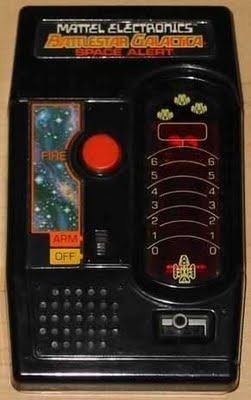
Yes, it's my old Mattel Electronics "Battlestar Galactica Space Alert" game, which I'm pretty sure I got for Christmas way, way back in 1978. I had to change the battery, of course, but the thing still works almost perfectly. It's as simple as a game can get, with a fire button and that joystick-sort-of-thing at the bottom that toggles your LED dot between the three spaces at the bottom of the screen. Other LED dots come down from above, and you have to "shoot" them, scoring more points the higher on the screen you hit them. If you take a hit in the middle space, you're done -- no extra men, no bonus rounds. Also, there's a set amount of attacks you have to endure, meaning your top score isn't going to be much more than 80 or so.
Compared to the Nintendo DS my six-year-oldi daughter was playing on the same trip, it looked crude and primitive indeed. But I still had (and have) fun playing "Space Alert," and it took me back to those days of the late 1970s when classrooms echoed with the tiny sounds of Mattel Electronics games. This one was never as popular as the all-time fave, Mattel Electronics Football, but as a science fiction geek instead of a sports geek, it's the one I preferred.
Oddly enough, I was never that big a fan of the show that "inspired" it. Sure, I watched "Battlestar Galactica," because in those pre-home video days, you took your space-based entertainment where you could get it. But I remember watching the show in a constant state of near boredom, wishing that somehow it could be "Star Wars " instead. (It's hard to believe just how much the fast-paced thrills of "Star Wars" -- which looks downright sedate and measured today -- spoiled all the ripoffs that were aimed at taking its place, along with our money). But no, it was just the same scenes of the same actors in the same hallway sets, then the same inconclusive space battles (with the same footage) between Apollo and Starbuck and the Cylons, then back to those hallways for more of ... well, you get the idea.
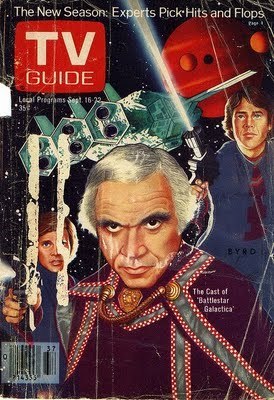
When "Battlestar Galactica" premiered, the "movie-length" pilot episode was so heavily hyped that, somehow, I thought it would be as good as "Star Wars" -- or at least good enough to take its place until "Star Wars" returned to theaters (as it was known to do). So, these being the pre-home video days, I convinced my dad to record the entire show on his reel-to-reel tape recorder, figuring I could then at least relive the audio thrills of the show.
I still remember how many times I listened to that tape: None. It was that boring. Even as an 11-year-old nerd, I had no desire to experience that pilot episode a second time. Watching the new episodes (hallways, space battles, repeat as necessary) was boring enough.
But at least the game was still fun. Hell, it still is.
This blog post -- and all the blog posts in the "Advance Team Tuesday" series -- are brought to you by "The Advance Team," the graphic novel Tor/Forge will be publishing in the spring, with script by yours truly and art by German Torres. Read more about it here.

Believe me, it was time well spent. Especially because, while rummaging through my mom's attic, I found this...

Yes, it's my old Mattel Electronics "Battlestar Galactica Space Alert" game, which I'm pretty sure I got for Christmas way, way back in 1978. I had to change the battery, of course, but the thing still works almost perfectly. It's as simple as a game can get, with a fire button and that joystick-sort-of-thing at the bottom that toggles your LED dot between the three spaces at the bottom of the screen. Other LED dots come down from above, and you have to "shoot" them, scoring more points the higher on the screen you hit them. If you take a hit in the middle space, you're done -- no extra men, no bonus rounds. Also, there's a set amount of attacks you have to endure, meaning your top score isn't going to be much more than 80 or so.
Compared to the Nintendo DS my six-year-oldi daughter was playing on the same trip, it looked crude and primitive indeed. But I still had (and have) fun playing "Space Alert," and it took me back to those days of the late 1970s when classrooms echoed with the tiny sounds of Mattel Electronics games. This one was never as popular as the all-time fave, Mattel Electronics Football, but as a science fiction geek instead of a sports geek, it's the one I preferred.
Oddly enough, I was never that big a fan of the show that "inspired" it. Sure, I watched "Battlestar Galactica," because in those pre-home video days, you took your space-based entertainment where you could get it. But I remember watching the show in a constant state of near boredom, wishing that somehow it could be "Star Wars " instead. (It's hard to believe just how much the fast-paced thrills of "Star Wars" -- which looks downright sedate and measured today -- spoiled all the ripoffs that were aimed at taking its place, along with our money). But no, it was just the same scenes of the same actors in the same hallway sets, then the same inconclusive space battles (with the same footage) between Apollo and Starbuck and the Cylons, then back to those hallways for more of ... well, you get the idea.

When "Battlestar Galactica" premiered, the "movie-length" pilot episode was so heavily hyped that, somehow, I thought it would be as good as "Star Wars" -- or at least good enough to take its place until "Star Wars" returned to theaters (as it was known to do). So, these being the pre-home video days, I convinced my dad to record the entire show on his reel-to-reel tape recorder, figuring I could then at least relive the audio thrills of the show.
I still remember how many times I listened to that tape: None. It was that boring. Even as an 11-year-old nerd, I had no desire to experience that pilot episode a second time. Watching the new episodes (hallways, space battles, repeat as necessary) was boring enough.
But at least the game was still fun. Hell, it still is.
This blog post -- and all the blog posts in the "Advance Team Tuesday" series -- are brought to you by "The Advance Team," the graphic novel Tor/Forge will be publishing in the spring, with script by yours truly and art by German Torres. Read more about it here.
Published on July 26, 2011 00:00
July 16, 2011
Remember H.E.R.O.? This guy does
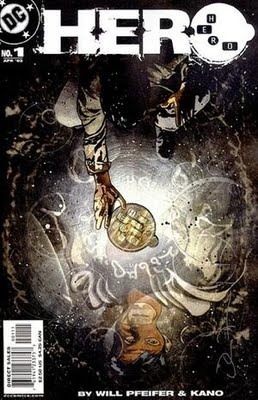
Over at his pop culture site "It's Bloggerin' Time," Colin Bell looks back at H.E.R.O, the 22-issue series I wrote back in the mid 2000s with art by such illustrious talents as Kano, Pat Gleason, Leonard Kirk and Dale Eaglesham.
Colin talks about how the disparate storylines all tied together in the slam-bang finale, and mentions how the series' actual final issue wasn't No. 22, but instead, it was No. 11...
"Not only did Pfeifer stick the landing though, he also snuck an epilogue to the series in as issue eleven without it being apparent until you'd read the final issue. It's an audacious trick that I've never seen repeated since, and I'd love to know if it was as a result of the cancellation being announced, or if it was just stuck in there as an entertaining story that the writer managed to wring more significance out of in hindsight towards the end of the book."
To answer your question, Colin, it was originally written as an single issue story in the middle of the run, but when the end was near and I wanted to do something dramatic with the title, I figured that was the perfect solution.
Glad you enjoyed it -- and thanks for the write-up!
Published on July 16, 2011 06:59
July 12, 2011
Advance Team Tuesday: The sci-fi authors series continues with a slightly shorter post about William Gibson

I didn't discover William Gibson until college, a couple of years after his breakthrough novel, 1984's "Neuromancer," hit the shelves. So, unlike Philip Jose Farmer and Harlan Ellison, I never had that young fan's frenzy for reading every single book of his I could get my hands on (and, frankly, back then, Gibson didn't have that many books out).
But unlike Farmer and Ellison, Gibson -- a guy from another generation who was covering subjects completely different than those two -- delivered a style of slick, cool and above all modern (or at least modern-seeming) sci-fi that was just what I wanted to read at that point. I think the first time I heard Gibson's name was in a Comics Journal (there's that mag again) review of Howard Chaykin's "American Flagg," where the reviewer compared Chaykin's use of clever, slightly satirical names ("Mananacillin," "Nachtmacher") to Gibson's portrayal of a future where business and consumer interests were the driving force behind everything. Well, I loved "American Flagg" (still do, in fact), so I figured I'd better check this Gibson fellow out.
Gibson's style in his early writing was so slick and of-the-moment in the late 1980s that it feels a little bit dated these days, with all the edgy hackers and corporate assassins and neon-lit massive cities. But that's the risk you run with edgy writing -- eventually, it's going to seem a lot less edgy. It still reads well, decades later, and it's still a hell of a lot of fun. What's more, unlike almost everyone else, Gibson was able to tap into the feeling that something big was about the happen, and it had nothing to do with spaceships or aliens or jetpacks or robots. No, it had to do with those computers that were showing up on everyone's desks and the way you could connect them to a phone and use them to talk to other computers.
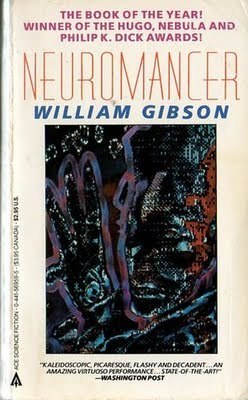 Gibson didn't predict cyberspace, but he did paint a picture of it that still seems, if not accurate, then startlingly evocative. Here's what "console cowboy" Case sees when he finally "jacks in," from page 52 of my Ace Books paperback edition of "Neuromancer":
Gibson didn't predict cyberspace, but he did paint a picture of it that still seems, if not accurate, then startlingly evocative. Here's what "console cowboy" Case sees when he finally "jacks in," from page 52 of my Ace Books paperback edition of "Neuromancer":"And if flowed, flowered for him, fluid neon orgami trick, the unfolding of his distanceless home, his country, transparent 3D chessboard extending to infinity. Inner eye opening to the stepped scarlet pyramid of the Eastern Seaboard Fission Authority burning beyond the green cubes of Mitsubishi bank of America, and high and very far away he saw the spiral arms of military systems, forever beyond his reach."
That's a nice piece of writing, there. From the telling detail of the "Mitsubish Bank of America" to the almost Lovecraftian image of the "spiral arms of military systems," it really makes the internet seem like some overwhelming force that's barely understandable by mere humans. And I guess that's sort of what it is, isn't it -- though the real internet turned out to be (a) a lot more DIY than what Case glimpses and (b) a lot sloppier and less organized.
I mean, think about it. You're reading this blog post on the exact same thing Gibson describes in this paragraph. So where are those spiral arms?
By the way, this blog post -- and all the blog posts in the "Advance Team Tuesday" series -- are brought to you by "The Advance Team," the graphic novel Tor/Forge will be publishing in the spring, with script by yours truly and art by German Torres. Read more about it here.
And pick up a copy when it hits the stores, OK? Maybe it'll be my "Neuromancer."
Published on July 12, 2011 06:51
July 10, 2011
The best looking travel poster ever?
Via Boing Boing, here's a vintage 1965 TWA travel poster celebrating all things grand and glorious about Las Vegas in its heyday.
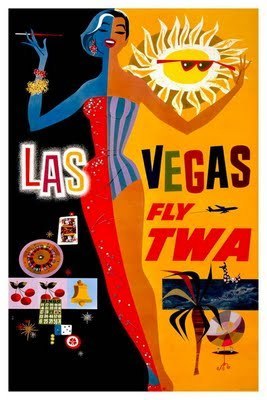
According to the actual post over at this LiveJournal page, the artist was David Klein, who worked in the 1950s and 1960s and won awards for his TWA campaign -- well-deserved awards, I'd say. I'll bet cartoonist Darwyn Cooke is a fan of Mr. Klein's work, and I wouldn't be surprised if the Pixar boys who brought us the short "Night and Day" were familiar with this poster, too.
Click on the LiveJournal link to see more of Klein's work, along with a photo of the man himself. Not surprisingly, he looks like someone who wandered in off the set of "Mad Men" -- though, of course, he was the real thing.

According to the actual post over at this LiveJournal page, the artist was David Klein, who worked in the 1950s and 1960s and won awards for his TWA campaign -- well-deserved awards, I'd say. I'll bet cartoonist Darwyn Cooke is a fan of Mr. Klein's work, and I wouldn't be surprised if the Pixar boys who brought us the short "Night and Day" were familiar with this poster, too.
Click on the LiveJournal link to see more of Klein's work, along with a photo of the man himself. Not surprisingly, he looks like someone who wandered in off the set of "Mad Men" -- though, of course, he was the real thing.
Published on July 10, 2011 09:29
July 7, 2011
Will Catwoman comic inspire Batman movie?
The movie geeks over at Total Film offered up "18 Comic Book Inspirations" that they're advising writer/director Christopher Nolan to consider for Catwoman in his upcoming movie, "The Dark Night Rises."
Putting aside the fact that I'm not wild about the casting of Anne Hathaway as Catwoman (C'mon! Nolan had the perfect Catwoman right in front of him in the person of Marion Cotillard!), I can't help but agree with some of Total Film's tips. Especially this one...
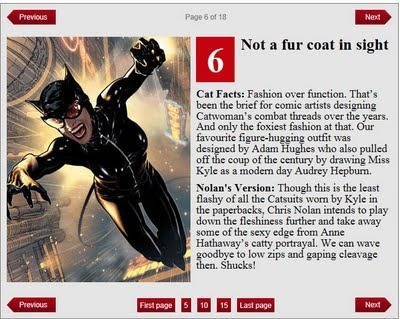
And this one ...
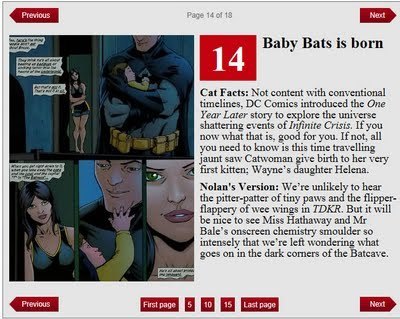
And that's not just because they're inspired by the work Adam Hughes, David Lopez, Nachie Castro, myself and the rest of the crew did during our run on the Catwoman comic book. It's because they're damn good ideas. (Though, admittedly, adding a baby into the plot of "The Dark Knight Rises" would be a bit tricky.)
Of course, if Nolan would like to cut us a check, too, that'd be the icing on the cake...
Putting aside the fact that I'm not wild about the casting of Anne Hathaway as Catwoman (C'mon! Nolan had the perfect Catwoman right in front of him in the person of Marion Cotillard!), I can't help but agree with some of Total Film's tips. Especially this one...

And this one ...

And that's not just because they're inspired by the work Adam Hughes, David Lopez, Nachie Castro, myself and the rest of the crew did during our run on the Catwoman comic book. It's because they're damn good ideas. (Though, admittedly, adding a baby into the plot of "The Dark Knight Rises" would be a bit tricky.)
Of course, if Nolan would like to cut us a check, too, that'd be the icing on the cake...
Published on July 07, 2011 18:29
July 3, 2011
Advance Team Tuesday: The sci-fi authors series continues with a long, rambling post about Harlan Ellison
More of my rambling, self-indulgent look back at some of the science fiction writers who indirectly inspired the graphic novel "The Advance Team," which hits stores in 2012.
I remember the first time I became aware of Harlan Ellison, mostly because I had no idea who he was. It was an issue of Starlog, sometime in early 1980s, and it was in an article focused on -- of all things -- a company that made baseball caps for science fiction movies. You know, like the caps the crew of the Nostromo wore in "Alien" (a movie that I hadn't seen at that point, either.) There was a picture of Ellison wearing (a) a big grin and (b) a baseball cap that said "HARLAN ELLISON." The caption under the photo said something along the lines of "Why is this man smiling?" I didn't know -- because I didn't know who that man was.
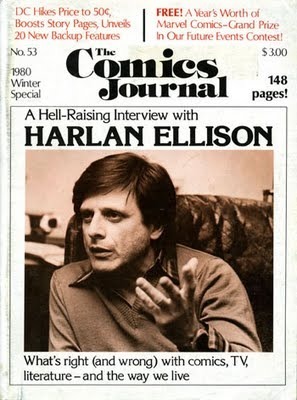
It wasn't until I started reading The Comics Journal a bit later that I encountered Ellison in all his mid-career glory. It's strange now, considering how Ellison and Comics Journal chief Gary Groth have become mortal enemies over the last few decades, but back then, you couldn't pick up an issue of The Comics Journal without seeing Ellison's face -- and I mean literally. There was that picture of him wearing a Tazmanian Devil T-shirt, the classic arms-folded, 1970s glasses pose and even an image in an ad for something called "The Harlan Ellison Record Club" (or something like that -- it's been a few years) where you could buy audio recordings of Ellison speaking. In other words, if you were reading The Comics Journal back then, you couldn't help but be aware of Ellison.
And that interview in the issue pictured above was -- and remains -- notorious. It was the talk, of course, that inspired the lawsuit from comics writer Michael Fleischer that dragged on for years (and, by most accounts, ended the Ellison-Groth friendship), but other than that it featured Ellison taking aim at just about everyone working in comics, and everyone working out of comics, too. I didn't know who the heck Jorge Luis Borges or Hunter S. Thompson or Donald Barthleme were, but I had to admit, it was interesting reading someone who obviously loved to talk go on about people like that -- and go on (and on and on) about himself, too. He sounded like a pretty interesting guy.
So, I scouted my local used book store (the Paper Back Shack in Niles, Ohio -- still in business!) for whatever copies of Ellison's writing I could find, then haunted the shelves of the local new bookstore (Waldenbooks, not in business) for the stuff of his that was still in print. I managed to build a fairly complete collection, everything from "The Beast that Shouted Love at the Heart of the World" (with the classic novella "A Boy and His Dog") to his two-part collection of TV writing, "The Glass Teat." A lot of it sailed over my head (especially all that talk about guys like Spiro Agnew in "The Glass Teat" books), but a lot of it connected, too.
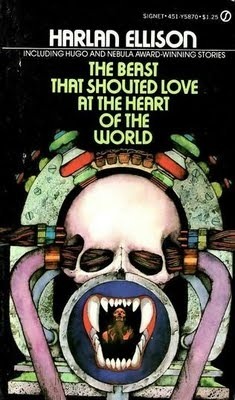 I've always thought Ellison's writing holds a special appeal for young men stumbling through adolescence with a little bit of frustration, a little bit of suspicion and a little bit of smarts -- or at least enough smarts to realize the world isn't what everyone's been telling you it is. Ellison obviously loves to write -- his stories are full of wordy, elaborate and imaginative names and whirlwind flights of fancy. This is no stripped-down prose trying to be grown-up, it's like a teen who just discovered he could make up his own stories was turned loose on a typewrite. Maybe that's why I liked Ellison so much as an adolescent -- he wrote the way I would have written if I could've written that way.
I've always thought Ellison's writing holds a special appeal for young men stumbling through adolescence with a little bit of frustration, a little bit of suspicion and a little bit of smarts -- or at least enough smarts to realize the world isn't what everyone's been telling you it is. Ellison obviously loves to write -- his stories are full of wordy, elaborate and imaginative names and whirlwind flights of fancy. This is no stripped-down prose trying to be grown-up, it's like a teen who just discovered he could make up his own stories was turned loose on a typewrite. Maybe that's why I liked Ellison so much as an adolescent -- he wrote the way I would have written if I could've written that way.
Loud, fast-paced, smart-assed, profane and full of big words and bigger attitude. And, more than anything, self-obsessed. When Ellison wasn't crafting his own autobiographical books ("Memos from Purgatory") or writing fiction that obviously starred some version of him (" 'Repent, Harlequin,' Said the Ticktockman"), he was penning long intros to his short story collections (and I mean intros to each story, not just for the whole book) or writing criticism and essays that wound up being reprinted -- where else? -- in the pages of The Comics Jousnal. It was heady stuff compared to most of the other fiction (and nonfiction, for that matter) that I was reading.
Ellison always preferred the term "speculative fiction" to "science fiction" (and boy oh boy did he hate the term "sci-fi"), mostly because few of his stories revolved around any sort of "science." Even the ones set squarely in some sort of technological future, like " 'Repent, Harlequin,' said the Ticktockman" or "Along the Scenic Route" just used a bit of thrown-together science to bring the stories to life. It was the characters and the tales that were important -- not the technology. And plenty of Ellison's stories fit into the "horror" or "fantasy" categories, with no science at all. That was the real fun of picking up a collection of Ellison's short stories -- you really never knew what you were going to get.
I kept reading and re-reading Ellison through high school and much of college, but eventually, the usual other interests came along and pushed most of my science fiction reading off to the side. (I was still reading The Comics Journal, though by this time, the Ellison had moved to the "enemies" column.) But, during my senior year at Kent State, we got word that Ellison was going to speak on campus to help raise money for a memorial to the Kent State students who , were shot by the Ohio National Guard back in 1970. (Ellison dedicated his short story collection "Alone Against Tomorrow" to those four students.)
Someone was going to interview Ellison for the pre-speech story, and as an editor on the school paper, I assigned myself that task. It was a phoner, as they say, and I spent the better part of two hours sealed up in an office talking to the guy I had once considered the greatest writer of all time. As you might guess, it was a fascinating conversation, because, even more than he loves to write, Harlan Ellison loves to talk. Much of the conversation, if I remember correctly, focused on the Kent State protests and the political aspects of the shootings (always a hot topic at my alma mater), but plenty of other topics were touched upon, too. His speech a few nights later was along the same lines, with plenty of question-and-answer time and a book signing afterwards.
Though I still had (and still have) all those paperbacks from my high school days, I only had one actual Harlan Ellison hardback in my collection, so that's what I took to get signed -- a book club edition of "Dangerous Visions," the groundbreaking science fiction collection compiled and edited by Ellison that arrived on this planet in 1967, the same year I did.
And yes, I still have that book, too.
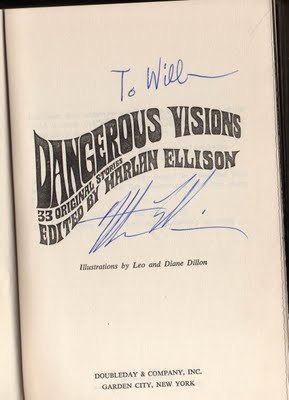

I remember the first time I became aware of Harlan Ellison, mostly because I had no idea who he was. It was an issue of Starlog, sometime in early 1980s, and it was in an article focused on -- of all things -- a company that made baseball caps for science fiction movies. You know, like the caps the crew of the Nostromo wore in "Alien" (a movie that I hadn't seen at that point, either.) There was a picture of Ellison wearing (a) a big grin and (b) a baseball cap that said "HARLAN ELLISON." The caption under the photo said something along the lines of "Why is this man smiling?" I didn't know -- because I didn't know who that man was.

It wasn't until I started reading The Comics Journal a bit later that I encountered Ellison in all his mid-career glory. It's strange now, considering how Ellison and Comics Journal chief Gary Groth have become mortal enemies over the last few decades, but back then, you couldn't pick up an issue of The Comics Journal without seeing Ellison's face -- and I mean literally. There was that picture of him wearing a Tazmanian Devil T-shirt, the classic arms-folded, 1970s glasses pose and even an image in an ad for something called "The Harlan Ellison Record Club" (or something like that -- it's been a few years) where you could buy audio recordings of Ellison speaking. In other words, if you were reading The Comics Journal back then, you couldn't help but be aware of Ellison.
And that interview in the issue pictured above was -- and remains -- notorious. It was the talk, of course, that inspired the lawsuit from comics writer Michael Fleischer that dragged on for years (and, by most accounts, ended the Ellison-Groth friendship), but other than that it featured Ellison taking aim at just about everyone working in comics, and everyone working out of comics, too. I didn't know who the heck Jorge Luis Borges or Hunter S. Thompson or Donald Barthleme were, but I had to admit, it was interesting reading someone who obviously loved to talk go on about people like that -- and go on (and on and on) about himself, too. He sounded like a pretty interesting guy.
So, I scouted my local used book store (the Paper Back Shack in Niles, Ohio -- still in business!) for whatever copies of Ellison's writing I could find, then haunted the shelves of the local new bookstore (Waldenbooks, not in business) for the stuff of his that was still in print. I managed to build a fairly complete collection, everything from "The Beast that Shouted Love at the Heart of the World" (with the classic novella "A Boy and His Dog") to his two-part collection of TV writing, "The Glass Teat." A lot of it sailed over my head (especially all that talk about guys like Spiro Agnew in "The Glass Teat" books), but a lot of it connected, too.
 I've always thought Ellison's writing holds a special appeal for young men stumbling through adolescence with a little bit of frustration, a little bit of suspicion and a little bit of smarts -- or at least enough smarts to realize the world isn't what everyone's been telling you it is. Ellison obviously loves to write -- his stories are full of wordy, elaborate and imaginative names and whirlwind flights of fancy. This is no stripped-down prose trying to be grown-up, it's like a teen who just discovered he could make up his own stories was turned loose on a typewrite. Maybe that's why I liked Ellison so much as an adolescent -- he wrote the way I would have written if I could've written that way.
I've always thought Ellison's writing holds a special appeal for young men stumbling through adolescence with a little bit of frustration, a little bit of suspicion and a little bit of smarts -- or at least enough smarts to realize the world isn't what everyone's been telling you it is. Ellison obviously loves to write -- his stories are full of wordy, elaborate and imaginative names and whirlwind flights of fancy. This is no stripped-down prose trying to be grown-up, it's like a teen who just discovered he could make up his own stories was turned loose on a typewrite. Maybe that's why I liked Ellison so much as an adolescent -- he wrote the way I would have written if I could've written that way. Loud, fast-paced, smart-assed, profane and full of big words and bigger attitude. And, more than anything, self-obsessed. When Ellison wasn't crafting his own autobiographical books ("Memos from Purgatory") or writing fiction that obviously starred some version of him (" 'Repent, Harlequin,' Said the Ticktockman"), he was penning long intros to his short story collections (and I mean intros to each story, not just for the whole book) or writing criticism and essays that wound up being reprinted -- where else? -- in the pages of The Comics Jousnal. It was heady stuff compared to most of the other fiction (and nonfiction, for that matter) that I was reading.
Ellison always preferred the term "speculative fiction" to "science fiction" (and boy oh boy did he hate the term "sci-fi"), mostly because few of his stories revolved around any sort of "science." Even the ones set squarely in some sort of technological future, like " 'Repent, Harlequin,' said the Ticktockman" or "Along the Scenic Route" just used a bit of thrown-together science to bring the stories to life. It was the characters and the tales that were important -- not the technology. And plenty of Ellison's stories fit into the "horror" or "fantasy" categories, with no science at all. That was the real fun of picking up a collection of Ellison's short stories -- you really never knew what you were going to get.
I kept reading and re-reading Ellison through high school and much of college, but eventually, the usual other interests came along and pushed most of my science fiction reading off to the side. (I was still reading The Comics Journal, though by this time, the Ellison had moved to the "enemies" column.) But, during my senior year at Kent State, we got word that Ellison was going to speak on campus to help raise money for a memorial to the Kent State students who , were shot by the Ohio National Guard back in 1970. (Ellison dedicated his short story collection "Alone Against Tomorrow" to those four students.)
Someone was going to interview Ellison for the pre-speech story, and as an editor on the school paper, I assigned myself that task. It was a phoner, as they say, and I spent the better part of two hours sealed up in an office talking to the guy I had once considered the greatest writer of all time. As you might guess, it was a fascinating conversation, because, even more than he loves to write, Harlan Ellison loves to talk. Much of the conversation, if I remember correctly, focused on the Kent State protests and the political aspects of the shootings (always a hot topic at my alma mater), but plenty of other topics were touched upon, too. His speech a few nights later was along the same lines, with plenty of question-and-answer time and a book signing afterwards.
Though I still had (and still have) all those paperbacks from my high school days, I only had one actual Harlan Ellison hardback in my collection, so that's what I took to get signed -- a book club edition of "Dangerous Visions," the groundbreaking science fiction collection compiled and edited by Ellison that arrived on this planet in 1967, the same year I did.
And yes, I still have that book, too.

Published on July 03, 2011 00:10
June 28, 2011
Advance Team Tuesday: A long, rambling bit about science fiction authors, Philip Jose Farmer in particular
You know, even though "The Advance Team" is, at least mostly (partly?) a science fiction graphic novel, I have to confess I haven't read a whole lot of science fiction in my life.
These days, it's mostly nonfiction, and back when most teens are plowing through volumes of sci-fi*, I was either (a) on a big Stephen King kick, prompted by seeing "Christine" in the theater and having a friend tell me "the book is much better." (Spoiler alert: He was right), or (b) embarking on my never-ending mission to read every damn movie book that's ever been published, initiated (at least in part) by Stephen King's "Danse Macabre," which is still one of the best books about horror you're going to find.
(Though, and please forgive this unrelated, cranky, nerdish digression, but King is completely wrong on at least two points in "Danse Macabre": 1. "Cat People" is one of the great horror movies (scratch that -- great movies) of all time, and the fact that King can't see past the studio sets to the wonder that lies beneath is his problem, not the film's. 2. King loves "Robot Monster" but claims that Ed Wood's "Plan 9 from Outer Space" is some sort of cheap, exploitative movie. He's got things exactly backwards. "Robot Monster" is fun, but it's a no-budget quickie cash-in directed by
Anyway, I did manage to read some science fiction during those formative years -- nothing too out of the ordinary, but I definitely had my favorites. In the next few installments of "Advance Team Tuesdays," I'll be spotlighting a few, with plenty of annoying digressions like the one above along the way. This week, the focus falls on the late, great Philip Jose Farmer
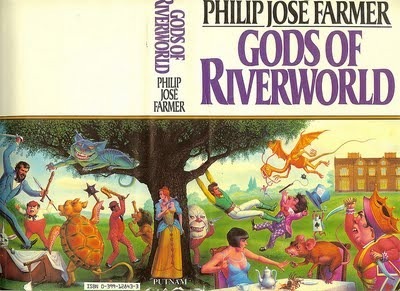 I wrote briefly about Farmer when he died back in 2009 (see that blog entry here), and mentioned that of all the science fiction epics I never read -- Asimov's "Foundation" books, "Dune," anything else you can name -- I did devour Farmer's multi-volume "Riverworld" series, where everyone who ever lived gets reborn on a giant planet encircled by a colossal river. It was wild, goofy, off-the-wall stuff, and Farmer knew how to keep things moving at a fast clip.
I wrote briefly about Farmer when he died back in 2009 (see that blog entry here), and mentioned that of all the science fiction epics I never read -- Asimov's "Foundation" books, "Dune," anything else you can name -- I did devour Farmer's multi-volume "Riverworld" series, where everyone who ever lived gets reborn on a giant planet encircled by a colossal river. It was wild, goofy, off-the-wall stuff, and Farmer knew how to keep things moving at a fast clip.
Geek that I was (aka am), I preferred his obsessively geeky books devoted to proving that Tarzan and Doc Savage were actual people, and I really liked his short story "After King Kong Fell" (read it here), where he tells "the real story" of the death of the big ape, complete with cameos from Doc Savage and the Shadow and (typically for Farmer) a couple of oddball sexual angles involving Kong, Fay Wray and the twist ending of the story.
I also have to give credit for Farmer providing a backwards introduction to my love of the Beats with his short story "The Jungle Rot Kid on the Nod," which retold the story of Tarzan (created, of course, by Edgar Rice Burroughs) in the vernacular of William Burroughs. Get it? I didn't get it much back then, having read neither Tarzan nor William Burroughs (I didn't even know what "the nod" was), but I knew there was something about that writing style I liked. It would be years before I actually read "Naked Lunch," but looking back, I'd say Farmer captured the tone as good as anyone has.
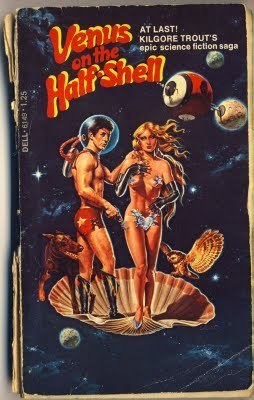 Farmer did a lot of that sort of thing, writing short pastiches as if he were (a) another author or (b) a fictional character who happened to be a writer. Probably his most elaborate gag along these lines was "Venus on the Half Shell," a short novel supposedly written by none other than Kilgore Trout, who appears in "Breakfast of Champions," "Slaughterhouse Five" and other novels by Kurt Vonnegut. "Venus on the Half Shell" was a title mentioned in Vonnegut's book "God Bless You, Mister Rosewater," but Farmer created an entire narrative out of those five words and somehow convinced Dell to print the thing (after it ran as a two-parter in a magazine). Vonnegut was apparently not amused, especially because everyone seemed to assume that he'd written it.
Farmer did a lot of that sort of thing, writing short pastiches as if he were (a) another author or (b) a fictional character who happened to be a writer. Probably his most elaborate gag along these lines was "Venus on the Half Shell," a short novel supposedly written by none other than Kilgore Trout, who appears in "Breakfast of Champions," "Slaughterhouse Five" and other novels by Kurt Vonnegut. "Venus on the Half Shell" was a title mentioned in Vonnegut's book "God Bless You, Mister Rosewater," but Farmer created an entire narrative out of those five words and somehow convinced Dell to print the thing (after it ran as a two-parter in a magazine). Vonnegut was apparently not amused, especially because everyone seemed to assume that he'd written it.
It was reprinted with Farmer's name prominently displayed, but the edition you really want (assuming you like these sort of pop culture jokes -- obviously I do) is the original paperback with "Kilgore Trout" listed as the only author, complete with a photo of him (Farmer in a beard and hat) on the back cover.
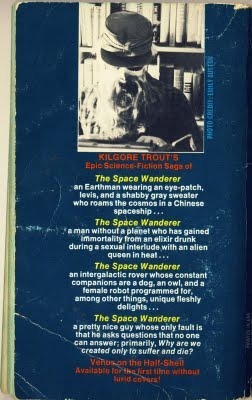 Next week, here at Advance Team Tuesdays, we'll discuss another sci-fi* author from my misspent, formative years, Mr. Harlan Ellison, a man I (a) actually met one and (b) had a long conversation with. Tune in, won't you?
Next week, here at Advance Team Tuesdays, we'll discuss another sci-fi* author from my misspent, formative years, Mr. Harlan Ellison, a man I (a) actually met one and (b) had a long conversation with. Tune in, won't you?
And in the meantime, why not start pestering your local bookseller or comic book shop owner about "The Advance Team," the Tor Forge science fiction graphic novel by artist German Torres and me that these entries are, after all, designed to hype? It doesn't hit the stores until next spring, but it's never too early to start building buzz, right?
* I only used the term "sci-fi" because I know it drives Harlan Ellison craaaaaaaazy.

These days, it's mostly nonfiction, and back when most teens are plowing through volumes of sci-fi*, I was either (a) on a big Stephen King kick, prompted by seeing "Christine" in the theater and having a friend tell me "the book is much better." (Spoiler alert: He was right), or (b) embarking on my never-ending mission to read every damn movie book that's ever been published, initiated (at least in part) by Stephen King's "Danse Macabre," which is still one of the best books about horror you're going to find.
(Though, and please forgive this unrelated, cranky, nerdish digression, but King is completely wrong on at least two points in "Danse Macabre": 1. "Cat People" is one of the great horror movies (scratch that -- great movies) of all time, and the fact that King can't see past the studio sets to the wonder that lies beneath is his problem, not the film's. 2. King loves "Robot Monster" but claims that Ed Wood's "Plan 9 from Outer Space" is some sort of cheap, exploitative movie. He's got things exactly backwards. "Robot Monster" is fun, but it's a no-budget quickie cash-in directed by
Anyway, I did manage to read some science fiction during those formative years -- nothing too out of the ordinary, but I definitely had my favorites. In the next few installments of "Advance Team Tuesdays," I'll be spotlighting a few, with plenty of annoying digressions like the one above along the way. This week, the focus falls on the late, great Philip Jose Farmer
 I wrote briefly about Farmer when he died back in 2009 (see that blog entry here), and mentioned that of all the science fiction epics I never read -- Asimov's "Foundation" books, "Dune," anything else you can name -- I did devour Farmer's multi-volume "Riverworld" series, where everyone who ever lived gets reborn on a giant planet encircled by a colossal river. It was wild, goofy, off-the-wall stuff, and Farmer knew how to keep things moving at a fast clip.
I wrote briefly about Farmer when he died back in 2009 (see that blog entry here), and mentioned that of all the science fiction epics I never read -- Asimov's "Foundation" books, "Dune," anything else you can name -- I did devour Farmer's multi-volume "Riverworld" series, where everyone who ever lived gets reborn on a giant planet encircled by a colossal river. It was wild, goofy, off-the-wall stuff, and Farmer knew how to keep things moving at a fast clip.Geek that I was (aka am), I preferred his obsessively geeky books devoted to proving that Tarzan and Doc Savage were actual people, and I really liked his short story "After King Kong Fell" (read it here), where he tells "the real story" of the death of the big ape, complete with cameos from Doc Savage and the Shadow and (typically for Farmer) a couple of oddball sexual angles involving Kong, Fay Wray and the twist ending of the story.
I also have to give credit for Farmer providing a backwards introduction to my love of the Beats with his short story "The Jungle Rot Kid on the Nod," which retold the story of Tarzan (created, of course, by Edgar Rice Burroughs) in the vernacular of William Burroughs. Get it? I didn't get it much back then, having read neither Tarzan nor William Burroughs (I didn't even know what "the nod" was), but I knew there was something about that writing style I liked. It would be years before I actually read "Naked Lunch," but looking back, I'd say Farmer captured the tone as good as anyone has.
 Farmer did a lot of that sort of thing, writing short pastiches as if he were (a) another author or (b) a fictional character who happened to be a writer. Probably his most elaborate gag along these lines was "Venus on the Half Shell," a short novel supposedly written by none other than Kilgore Trout, who appears in "Breakfast of Champions," "Slaughterhouse Five" and other novels by Kurt Vonnegut. "Venus on the Half Shell" was a title mentioned in Vonnegut's book "God Bless You, Mister Rosewater," but Farmer created an entire narrative out of those five words and somehow convinced Dell to print the thing (after it ran as a two-parter in a magazine). Vonnegut was apparently not amused, especially because everyone seemed to assume that he'd written it.
Farmer did a lot of that sort of thing, writing short pastiches as if he were (a) another author or (b) a fictional character who happened to be a writer. Probably his most elaborate gag along these lines was "Venus on the Half Shell," a short novel supposedly written by none other than Kilgore Trout, who appears in "Breakfast of Champions," "Slaughterhouse Five" and other novels by Kurt Vonnegut. "Venus on the Half Shell" was a title mentioned in Vonnegut's book "God Bless You, Mister Rosewater," but Farmer created an entire narrative out of those five words and somehow convinced Dell to print the thing (after it ran as a two-parter in a magazine). Vonnegut was apparently not amused, especially because everyone seemed to assume that he'd written it.It was reprinted with Farmer's name prominently displayed, but the edition you really want (assuming you like these sort of pop culture jokes -- obviously I do) is the original paperback with "Kilgore Trout" listed as the only author, complete with a photo of him (Farmer in a beard and hat) on the back cover.
 Next week, here at Advance Team Tuesdays, we'll discuss another sci-fi* author from my misspent, formative years, Mr. Harlan Ellison, a man I (a) actually met one and (b) had a long conversation with. Tune in, won't you?
Next week, here at Advance Team Tuesdays, we'll discuss another sci-fi* author from my misspent, formative years, Mr. Harlan Ellison, a man I (a) actually met one and (b) had a long conversation with. Tune in, won't you?And in the meantime, why not start pestering your local bookseller or comic book shop owner about "The Advance Team," the Tor Forge science fiction graphic novel by artist German Torres and me that these entries are, after all, designed to hype? It doesn't hit the stores until next spring, but it's never too early to start building buzz, right?
* I only used the term "sci-fi" because I know it drives Harlan Ellison craaaaaaaazy.
Published on June 28, 2011 06:41
Will Pfeifer's Blog
- Will Pfeifer's profile
- 23 followers
Will Pfeifer isn't a Goodreads Author
(yet),
but they
do have a blog,
so here are some recent posts imported from
their feed.



